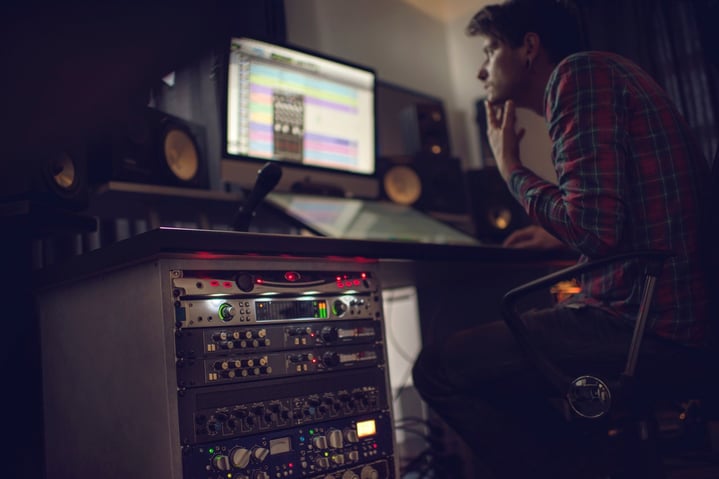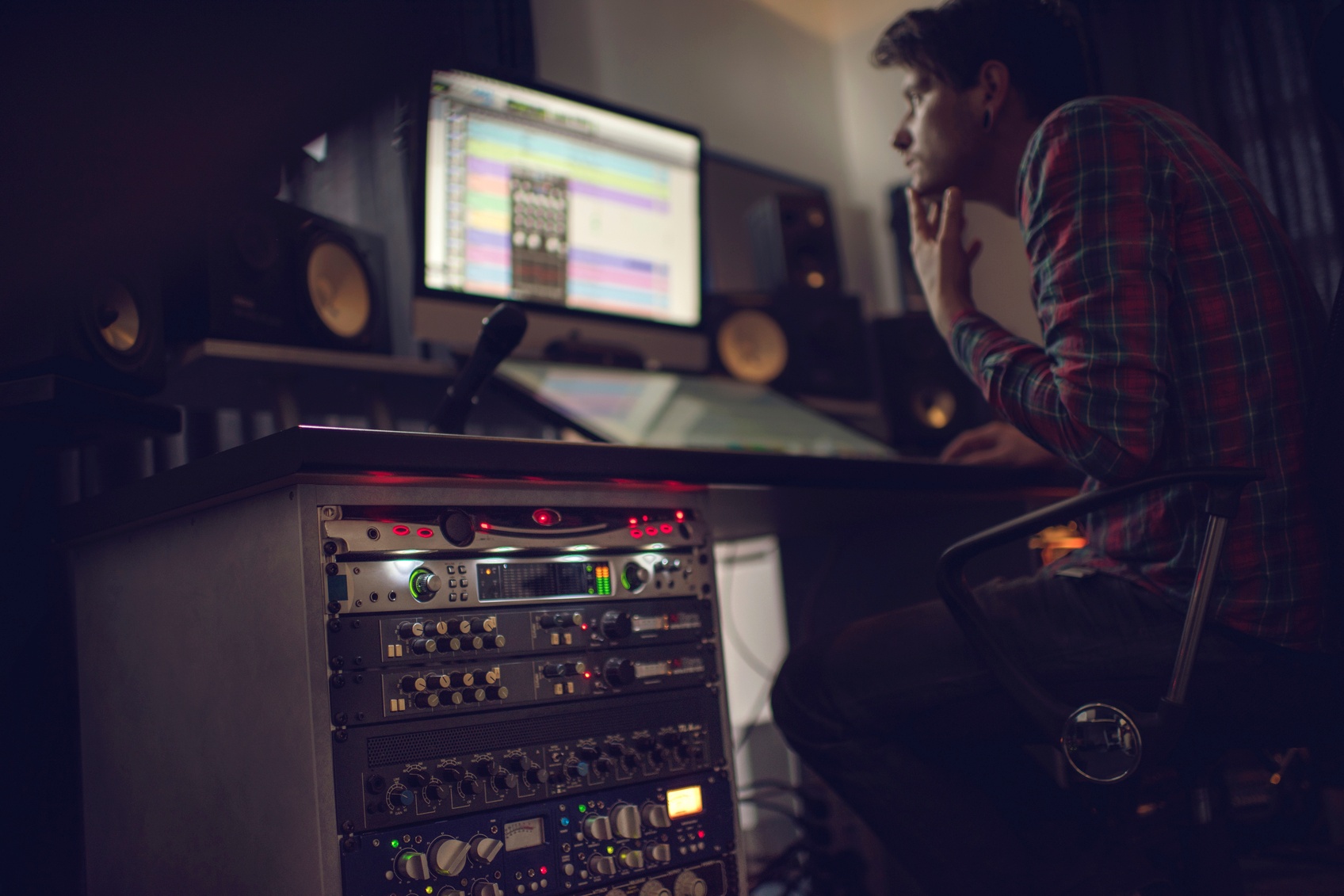Get Professional Sounding Vocals in Your Mix
Many people may have an idea in their head that it will take much more money than they can afford to make a vocal recording sound professional.
Well, you can toss that idea out of the window right now.
There are a few simple ways to improve the quality of a vocal recording while spending minimal money and getting a little creative with your recording space and things you may have lying around the house.
Table Of Contents
- Don't Be Lazy
- Use Plugins
- Sound Treat Your Recording Environment
- Be Honest With Yourself
- Equalization And Planning
- Getting Started
Here are 5 Tips to Make Your Vocal Recording Sound Higher Quality
1. Don’t be lazy
We live in a time where everything is at our fingertips, which is great, but at the same time, this could cause us to feel like we don’t need to take the extra step to make things be the best that they can be.
While using your built-in microphone in your laptop may get you by, it definitely won’t give you a high sound quality of recordings.
Go the extra step for your vocal recording sessions.
Take the time to research different dynamic microphones and audio interfaces and read the reviews that people have written on them. If you're on a tight budget, you'd be surprised at what a $99 microphone can achieve for you.
I’ve always found that the things I didn’t necessarily want to do, always ended up giving me a better final result.
2. Use Plugins
A plugin is a software that adds another feature to an existing computer program, which in your case will most likely be a recording software or DAW.
While some recording artists may have access to big recording studios stacked with the best equipment in the industry, most others are working with a smaller setup at home.
Don’t be discouraged in thinking that only people with access to these professional studios will get great results with their recordings.
You can get similar results at home through the magic world of plugins.
Some of these plugins will include compressors, delays, and reverbs. While more can be used, these three are pretty essential in almost all vocal recordings.
A great affordable solution would be CLA VOCALS, which includes all three of the previously mentioned effects into one. At a price of only $150, you can’t beat what you’re paying for. The hardware versions of the effects can be hundreds, if not thousands of dollars.
Even professional audio engineers use plugins to help improve audio quality.
3. Sound Treat Your Recording Environment
If you’ve already tried recording in your bedroom at home, you’ve probably realized that this may not be an optimal recording environment, and you aren’t getting a sound like the pros.
Chances are that it is not your recording equipment but the environment you’re recording in.
Most rooms in modern houses are in the shape of a cube, which is probably one of the worst places to record. The sound bouncing off all of the walls will make for a bad recording experience.
This being said you don’t need to spend thousands of dollars to get a better-sounding recording.
If you're on a limited budget, the most budget-friendly effective noise reduction technique is to hang thick blankets from the walls so the sound gets absorbed. Be careful though because absorbing too much sound can make the recording sound “dead”.
If you have more of a budget, an advanced recording technique would be to pick up some acoustic foam, which will absorb sound and prevent it from reflecting around the room.
You can go much farther than these minor upgrades, but you will see a drastic increase in recording quality when taking sound treatment and the acoustic environment into consideration.
You are not only trying to reduce the reflections around the room, but you are trying to get the unwanted noises to a minimum and improve audio quality.
Remember, nobody wants to hear background noise, like a subtle lawnmower in the far back of an audio recording.
4. Be Honest with Yourself
When listening back to your vocal session, if something sounds a little off, don’t just look past the issue, take the time and utilize the proper techniques to figure out the problem and fix it.
This detailed work is what separates the Pros from everyone else.
Sometimes it can be hard to want to fix something in the recording process once you’ve spent hours trying to master the perfect vocal session. Many times, you’ll already be in the headspace of thinking you are done with recording vocals, and you can move on.
Once you think you’re done with the vocals, a good practice is to step away for an hour or two and come back to listen again.
Getting your ears focused on something else will ultimately improve audio quality and the end result.
When coming back to your recording, listen to it and compare it to a song that is on the radio.
Be honest with yourself, and if it doesn’t meet the same criteria, you will know that you have to go back in and fix the audio quality.
A word of caution: Be careful not to over process the vocals, sometimes less is more.
-back to top
5. Equalization & Panning
A specific type of microphone may have heavy low-end frequencies and sometimes even harsh high frequencies.
An EQ can fix these issues.
You never want to compromise a vocal recording for any other instrument in a song.
The vocal is what everyone locks onto and wants to hear. You can carve out different frequencies in other instrument tracks to make room for the vocal, as well as rolling off lower frequencies of the vocal and much more.
Pro Tip: Panning instruments left or right will make room for the main vocal to be heard clearly.
Ultimately, you are trying to make room in your mix so that things can be heard clearly.
You don’t want it to sound muddy or for other instruments to get lost in the mix.
A good rule of thumb when EQ’ing vocals is to boost wide and cut thin.
This means when you are increasing frequencies, do it on a wider spectrum. When you are cutting frequencies out, make sure you are cutting them in a thinner spectrum because you don’t want to lose the voice quality or natural sound of the human voice.
Getting Started
These are 5 great ways to get a higher-quality and clean vocal recording while not breaking the bank.
Make sure you take the time to invest in your craft because if you love it, you won’t mind putting in a little extra time to make it near perfect.
All of these tips for recording vocals can be achieved with practice, and don’t get discouraged if the first time you try something, it doesn’t end up sounding like a pro-level recording.
Engineers dedicate their lives to making sure they can make a vocal sound great, and you can do the same if you follow these simple steps for recording vocals in your home.
If you’d like to learn more about pro-level recording, vocal mixing, and the music production process, check out our Certificate in Music Production or Music Production Degree Program at the Atlanta Institute of Music and Media.














